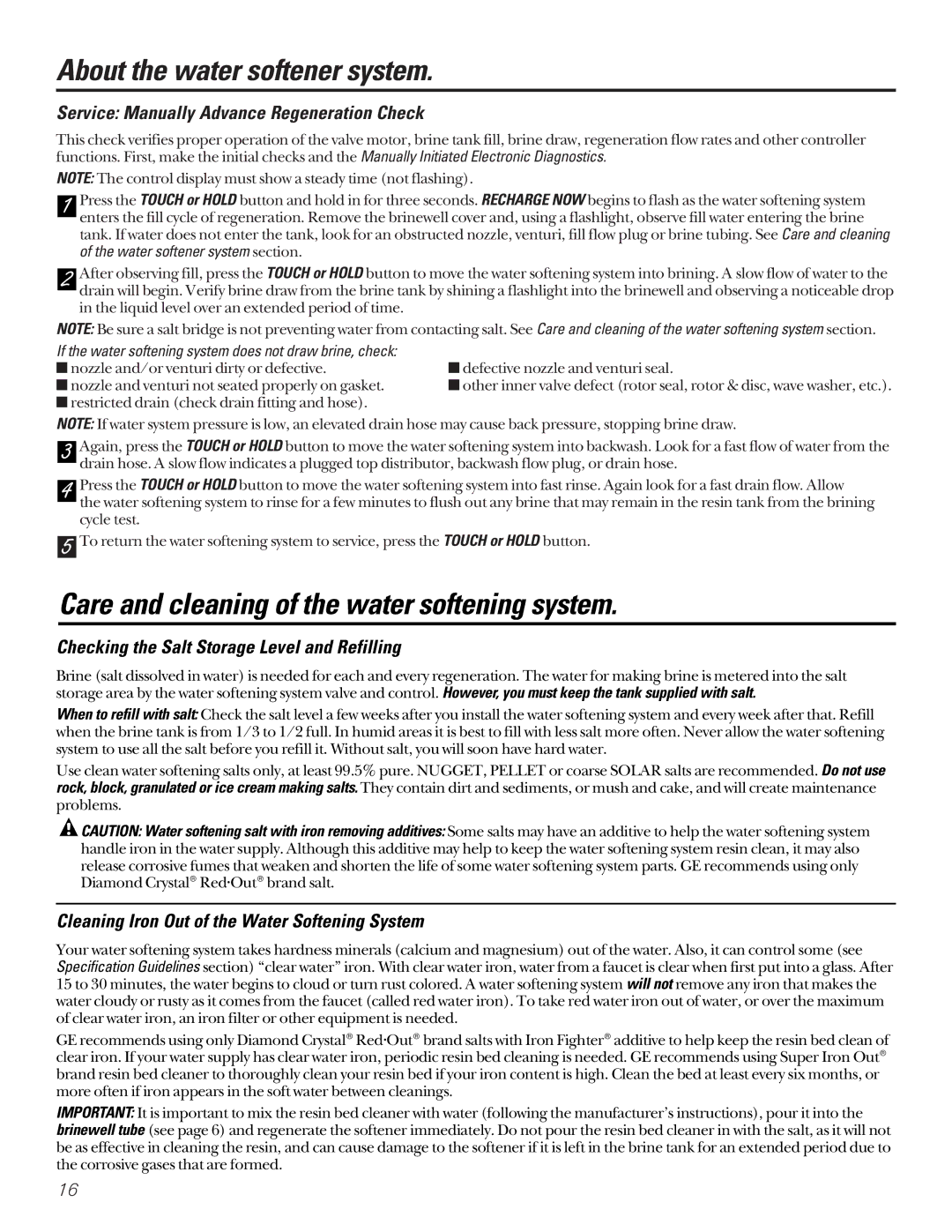Water Softening system
7227946 215C1044P015 49-5006108-00 JR
GE & You, a Service Partnership
Two easy ways to register your appliance
Safety Precautions
Installation instructions
Important Installation Recommendations
See Where to Install the Softener section for more details
Unpacking and Inspection
Where to Install the Softener
Plan How You Will Install the Softener
Tools and Materials Required for Installation
Typical Installation Illustration
Optional 3-Valve Bypass Installation Illustration
Step-by-step installation instructions
Install Bypass Valve
Move the Softener Assembly Into Installation Position
Plumb in and OUT Pipes to and from Softener
4A. Connecting a Rigid Valve Drain Tube
Install the Brine Tank Overflow Fittings and Hose
Connect to Electrical Power
ADD Water and Salt to the Brine Tank
Programming the Control
SET Present Time of DAY Present Time
SET Water Hardness Number
SET Regeneration Starting Time
Sanitizing Procedures
SPECIFICATIONS/DIMENSIONS GXSF27 GNSF35 GXSF39
About the water softener system
Breaking a Salt Bridge
Cleaning the Nozzle and Venturi Assembly
Cap
Feature Optional Recharge Controls
Feature Program Memory
Feature/Service Automatic Electronic Diagnostics
Normal Operation, Control Displays
To remove an error code 1 Unplug transformer
Service Timer/Softener, Service Checkout Procedure
ERR
SR31
SR22
SR35
Care and cleaning of the water softening system
Cleaning Iron Out of the Water Softening System
Checking the Salt Storage Level and Refilling
If the water softening system does not draw brine, check
Problem Possible Causes What To Do No soft water
Before you call for service…
That does not mix soft and hard water
After installation Water softening system
Not using any salt
After installation
Water feels slippery
Is cloudy Error Code on control
Resin beads showing
Up in drinking water Sink Sounds you might hear
Water has air bubbles
Parts list
153
Parts catalog
Switch
NUT Installation
Tube Installation
Housing Sensor
For The Period We Will Replace
What Is Not Covered
Warrantor General Electric Company. Louisville, KY
GE Water Softening System Warranty For Customers in Canada
Page
Directives d’installation
La section Française
Vous et GE, un partenariat de service
Conserver Soigneusement
Avertissement
Recommandations importantes pour l’installation
Directives d’installation
Déballage et inspection
Où installer l’adoucisseur
Planifiez comment vous allez installer l’adoucisseur
Outillage et matériel requis pour l’installation
Illustration d’une installation type
’EAU
Directives d’installation étape par étape
Installez LE Clapet DE Dérivation
SUR L’ORIFICE D’ENTRÉE DU Clapet DE L’ADOUCISSEUR
Raccordez ET Faites Fonctionner LE Tuyau DE Vidange
Installation D’ATTACHES DE Mise À LA Masse ET Câblage
’INSTALLATION Pour Détecter LES Fuites D’EAU
Ajout DE L’EAU ET DU SEL AU Réservoir DE Solution Saline
Programmation DU Panneau DE Commande
Programmation du panneau de commande
Affichage DE L’HEURE Actuelle Present Time
Affichage DE LA Dureté DE L’EAU
Programmation DE L’HEURE DE Régénération Début
SPÉCIFICATIONS/DIMENSIONS GXSF27 GNSF35 GXSF39
Pour terminer l’installation, suivez la méthode suivante
Méthode de sanitization
Au sujet du système adoucisseur d’eau
Élimination d’un pont de sel
Nettoyage de l’ensemble gicleur et venturi
Particularités Commandes pour recharge optionnelle
Affichages en utilisation normale
Particularité Mémoire du programme
Exemples
PAS D’EAU Traitée
Rectifiez l’anomalie Branchez le transformateur
Service Diagnostics manuels initiés manuellement
Tous les réglages de codes
Service Vérification de l’avance manuelle de régénération
Si l’adoucisseur n’aspire pas la solution saline, vérifiez
Entretien et nettoyage du système adoucisseur d’eau
Élimination du fer dans le système adoucisseur d’eau
Avant d’appeler un réparateur…
Problème Causes possibles Correctifs Pas d’eau traitée
Après l’installation
Parfois, l’eau est dure
’eau, l’eau paraît Être « glissante »
’eau ne consomme
’eau a un goût salé
Il y a des bulles dans
’eau qui est trouble
Erreur de code sur
Liste des pièces
153
Catalogue des pièces
Bouchonrégulateurde DÉBIT,COMMANDEDERINÇAGE
Écrou D’INSTALLATION
Tube D’INSTALLATION
Attache DE Tuyau
Page
Pour la période de Nous remplacerons
Ce qui n’est pas couvert
Un an
Trois ans
Numéros de téléphone pour le service
GE Answer Center Aux États-Unis
La sección Español
Instrucciones de instalación
Guarde los recibos de venta o los cheques cancelados aquí
GE & Usted, Una Asociación de Servicio
¡Dos formas fáciles de registrar su electrodoméstico
Escriba los números de modelo y serie aquí
Precauciones DE Seguridad
De usar exclusivamente el transformador incluido
Desempacado e inspección
Instrucciones de instalación
Recomendaciones importantes para la instalación
Dónde instalar el descalcificador
Planifique cómo instalará el descalcificador
Herramientas y materiales necesarios para la instalación
Ilustración de instalación típica
Ilustración de la instalación de un bypass de 3 válvulas
Instrucciones de instalación paso por paso
Instale LA Válvula DE Bypass
4A. Conectando UN Tubo DE Drenaje DE Válvula Rígida
Programación del Control
Notas
ESPECIFICACIONES/DIMENSIONES GXSF27 GNSF35 GXSF39
Procedimientos de desinfección
Acerca del sistema de descalcificación de agua
Rotura de un puente de sal
Limpiando la ensambladura de la boquilla y el Venturi
Operación normal, pantalla de control
Característica Controles opcionales de recargado
Característica Memoria del programa
Ejemplos
Posible Defecto
Servicio Diagnóstico electrónico iniciado manualmente
Haga Todos los ajustes del sincronizador
Cuidado y limpieza del sistema de descalcificación de agua
Servicio Inspección manual del avance de la regeneración
Antes de llamar para solicitar servicio…
Problema Posible causa Qué hacer No hay agua
Descalcificada
Problema Posible causa Qué hacer Veces el agua
Está dura
El agua se siente
De agua no está Usando ninguna
Problema Posible causa Qué hacer Las partículas
Agua y está Turbia Un error de
Usted puede
Escuchar El agua tiene
Lista de partes
153
Catálogo de partes
Espaciador
Interruptor
Pasador DE Expansión
Cubierta DE LA Válvula
Por el período de Nosotros remplazaremos
Garantía GE para el Sistema de Descalcificación de Agua
Lo que no está cubierto
Notas
Notas
Números Telefónicos de Servicio
TDD-GEAC
Service Telephone Numbers
U.S., call 800-TDD-GEAC Canada, contact

